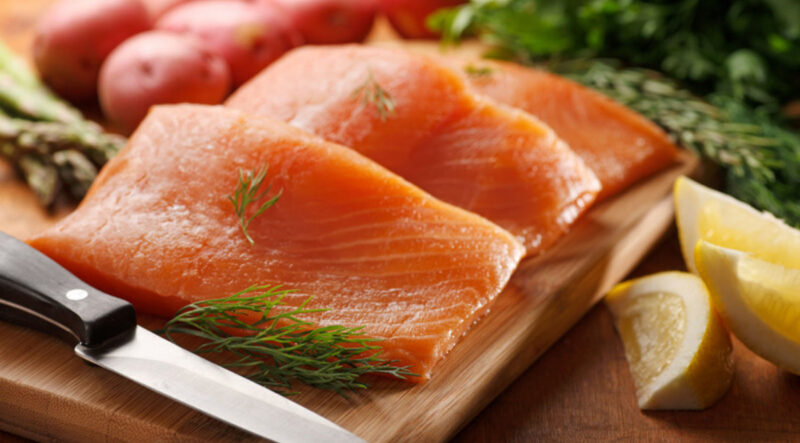BC salmon farm closures trigger record high prices
Price spikes are being driven by government decisions to reduce supply of BC’s farm-raised salmon, states the Canadian Aquaculture Industry Alliance (CAIA).
By Fabian Dawson
SeaWestNews
As food prices continue to soar, government decisions to shut down salmon farms in British Columbia have put the sustainably grown affordable protein out of reach for many Canadian families and grocers.
Spot prices for West Coast fresh Atlantic salmon are at record highs for this time of year, up 20 per cent over the last few years, with the price jump being driven by reduced supply of BC-grown farm-raised salmon said the Canadian Aquaculture Industry Alliance (CAIA).
“At a time of major food inflation resulting in higher prices for consumers, recent government decisions to shut down sustainable salmon farms, without scientific basis, and reduce supply to consumers is having a major price impact on this healthy, fresh and sustainable supply from Canada,” said Timothy Kennedy, President & CEO of CAIA.
“When the supply of farm-raised salmon drops, and demand continues, prices go up for Canadian families – it’s Economics 101,” said Kennedy as the government prepares to announce the future of salmon farms in the contentious Discovery Islands region of British Columbia.
Former federal Fisheries Minister Bernadette Jordan decided in Dec. 2020 to phase out 19 salmon farms in BC’s Discovery Islands, despite nine-peer reviewed scientific studies that showed the marine operations had virtually no impact on wild stocks migrating through the area.
Last week, another peer-reviewed Science ResponseReport published on the Department of Fisheries and Oceans Canada’s (DFO) website by the Canadian Science Advisory Secretariat (CSAS) concluded there is “no statistically relevant association” regarding sea lice and the production of farmed salmon.
The report dismantles a key claim by anti-fish farming activists’ groups that hazardous levels of naturally occurring parasitic sea lice in B.C. waters should necessitate the shutting down of the salmon farming industry.
The former minister also ignored staff recommendations for a more coordinated approach to the closures, which was primarily pushed for by anti-fish farm activists, who had threatened the Trudeau Liberals that they would withhold their votes for the party.
The Federal Court, however, last April ordered the government to set aside its decision to phase out the Discovery Islands salmon farms after reaffirming an earlier ruling that “salmon aquaculture in B.C. poses no more than a minimal risk to wild salmon.”
In response to the April 22, 2022 Federal Court decision, DFO started consultations with First Nations communities and current licence holders in the Discovery Islands.
“Considering these significant consultations and the volume of submissions, a decision on licensing in the Discovery Islands will be made in due course,” a DFO spokesperson told SeaWestNews yesterday.
Some salmon farmers have already stopped their aquaculture operations in the area.
CAIA said the supply from the Discovery Islands region was approximately 20,000 tonnes of salmon, the equivalent of 120 million meals and approximately one-quarter of the production of BC.
Replacing this Canadian salmon with product from other nations will result in an increased carbon footprint estimated at 163,000 tonnes of carbon due to air freight, or the same as adding 35,000 cars to the road.
Separately, the government is working on implementing an open-net pen transition plan for all of BC, expected to be finalized in the Spring of 2023.
“These salmon farming licensing decisions also impact Canada’s economy. Less Canadian farm-raised salmon for Canadian domestic consumption and export means lost jobs in rural, coastal and Indigenous communities, and higher GHG emissions as the Canadian salmon is replaced by product flown in from elsewhere around the world,” said Kennedy.
“It doesn’t make sense to have a policy to reduce production of a sustainable, healthy, affordable, food product like Canadian farm-raised salmon, and these past licensing decisions must be corrected by the federal government,” he said.
Sustainable, farm-raised salmon is the most popular seafood choice of North Americans, making up almost 4 of every 10 seafood choices.
Latest projections indicate the global supply of farmed Atlantic salmon will remain relatively flat in 2023, even as demand is projected to increase by about seven percent.
Market data firm Kontali said it anticipates Canada to suffer a 5 percent drop in farmed salmon production from 134,000 MT to 128,000 MT.
CAIA said Canada has an unparalleled opportunity to produce the very best, most sustainable farm-raised salmon in the world that supports families with fresh and healthy food at reasonable prices.
“Salmon farmers in Canada need strong positive signals from the federal government that they are committed to a collaborative partnership, based in peer-reviewed science, to grow this innovative sector,” said the Alliance, whose members employ 20,000 Canadians to generate over $5 billion in economic activity.
Meanwhile, Canada’s latest Food Price Report said the current rate for food price increases was at 10.3% as of September 2022.
There were nearly 1.5 million visits to food banks in 2022, marking the highest March use in history, and an increase in use of 35% from 2020 and 15% from 2021, the report said.
“In 2023, it is expected that Canadians will continue to feel the effects of high food inflation, and food insecurity/affordability will also be a big issue with rising food prices. The effects of climate change and the impact of high transportation costs, as a result of higher oil prices, will also continue through next year,” said the report.
(Image courtesy Cermaq)

